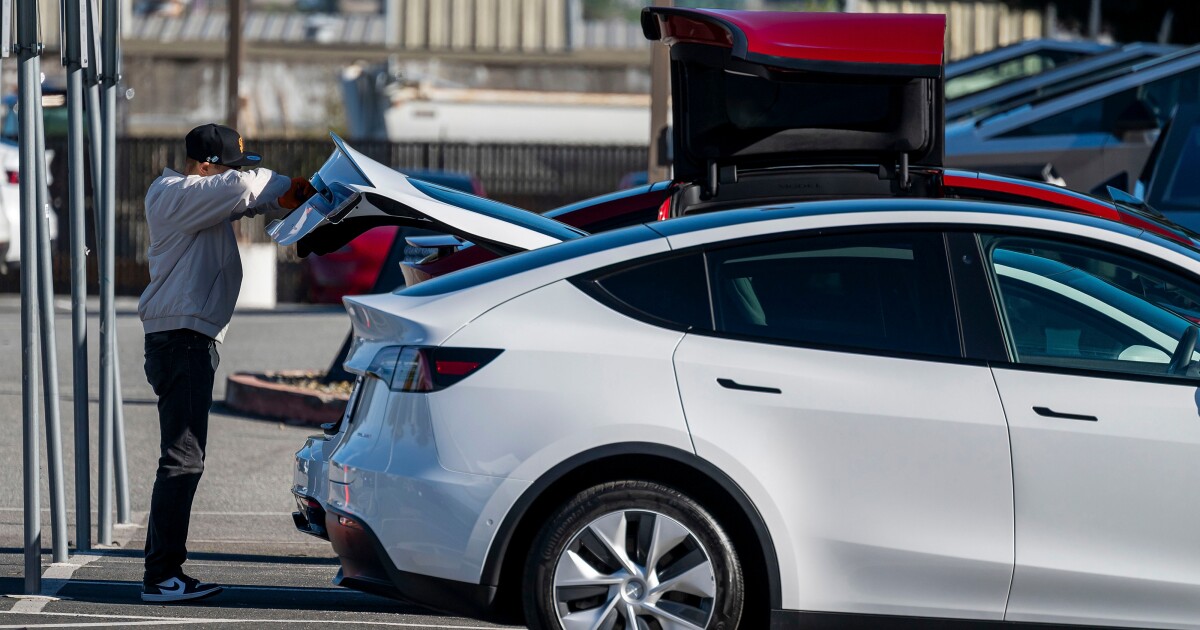President-elect Donald Trump’s threat to eliminate tax credits for electric vehicles likely gave plug-in cars a much-needed boost after a disappointing year, part of a broader surge in auto sales at the end of the year.
EV sales grew 12% in the fourth quarter of 2024, pushing the full-year total to a record 1.3 million, according to forecasts from researcher Cox Automotive. That’s up from an 8% growth rate in the previous quarter. Plug-in models make up around 8% of the overall US car market, only slightly more than a year ago.
A strong fourth quarter also helped push total car sales up from the year prior. The annualized rate for 2024 rose to 15.9 million cars, based on the average forecast of four researchers, up from 15.5 million a year ago.
This EV surge isn’t expected to last into 2025. The results of the U.S. presidential election encouraged buyers holding out for deals to make purchases before policy changes championed by Trump make electric options even more expensive next year.
Only a quarter of new-car shoppers are considering an EV for their next purchase, down two percentage points from a year ago, according to JD Power.
“Threats and worries” contributed to a “sense of urgency to buying,” Jonathan Smoke, Cox’s chief economist, said on a December call with reporters. “That’s true in overall purchase activity, and it’s also very much true to the EV story.”
Trump made repealing federal policies meant to boost U.S. EV sales a key part of his campaign, railing against what he called President Joe Biden’s “insane electric vehicle mandate.” Advisors to his transition team have recommended cutting the $7,500 tax credit on plug-in vehicles, which would make the already expensive vehicles even further out of reach for U.S. consumers. The president-elect has also threatened tariffs on Canada and Mexico — both tightly integrated into the U.S. auto supply chain — which could also drive up the price of cars.
As for the overall new car market, lower interest rates, rising manufacturer incentives and fading anxiety around the election drew more buyers, prompting analysts to raise full-year sales forecasts. Earlier in the year, inflation and a cyberattack on car dealerships had dimmed the sales outlook for 2024.
General Motors Co. was likely the the biggest automaker in the U.S. by sales last year, delivering 2.7 million cars, followed by Toyota Motor Corp., Ford Motor Co., Hyundai Motor Co. and Honda Motor Co., according to Cox.
Stellantis NV, which has been plagued by product launch delays and bloated inventories that led to the ouster of its CEO last year, fell to sixth place with a 15% plunge in deliveries, Cox forecast.
For EVs, Tesla Inc. is still the sales leader by far, but experienced its first annual sales drop in more than a decade last year despite reporting record fourth-quarter deliveries. Meanwhile, electric compact and mid-size SUVs from GM, Honda, Hyundai and Kia attracted more shoppers in December, according to JD Power.
Affordability is keeping car sales of all kinds below pre-pandemic levels, according to Jeff Schuster, GlobalData’s vice president of automotive research. The average retail transaction price for new vehicles is trending toward $46,258, according to JD Power. For EVs, high costs are the biggest stumbling block for potential buyers, followed by insufficient charging infrastructure.
On average, EV buyers got a $5,600 rebate per car with the current tax credit, JD Power figures show. Without that kind of incentive, demand could plunge as much as 27%, according to economists.
While some carmakers, like GM and Hyundai, have pledged to push ahead with EV offerings regardless of policy changes, others have delayed EV plans to prioritize hybrids, which saw outsized growth in 2024. Stellantis said last month it would delay launching its all-electric Ram a year in favor of an extended-range version. Hyundai said it would double its hybrid lineup and Ford has pledged to offer hybrid versions of all its models by 2030 after slashing prices on its EVs and postponing new electric models.
Automakers that take that “basket approach” will come out on top in 2025, GlobalData’s Schuster said. “If you have a full lineup of options, that’s who wins.”


 Economics1 week ago
Economics1 week ago
 Personal Finance1 week ago
Personal Finance1 week ago
 Personal Finance1 week ago
Personal Finance1 week ago
 Finance5 days ago
Finance5 days ago
 Personal Finance1 week ago
Personal Finance1 week ago
 Economics6 days ago
Economics6 days ago
 Accounting3 days ago
Accounting3 days ago
 Accounting1 week ago
Accounting1 week ago











